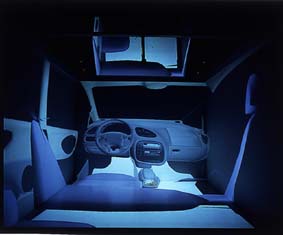CyberStage - An Advanced Virtual Environment
by Henrik Tramberend, Frank Hasenbrink, Gerhard Eckel, Ulrich Lechner and Martin Göbel
Virtual Environments now have come into age. Following the head bounded technology of the first days, now industrial applications in the Virtual Reality-Labs of the automotive industry are basically using stereo projection type systems like standard single screens, multiple screens.
The CyberStage is a 4 side room size stereo display system an enhanced CAVE-like-set-up which creates the illusion of immersion within a computer generated environment. Users may not only see large virtual spaces but also hear spatially distributed sound sources and experience vibrations associated with physical models like gravity.
GMD's research aims to develop intuitive man machine interfaces and cooperation metaphors for humans in virtual environments. Projection systems like the Responsive Workbench or the CyberStage allow a direct and body centred interaction within virtual worlds as well as team work in small groups. Due to these possibilities industrial applications today see many advantages in projection systems rather than in head coupled systems. GMD has installed the first CyberStage installation in late 1996 in its labs near Bonn. At CeBIT'97 a second, improved version was presented to the public.
User immersed in a virtual world are physically standing within the display system of the stage. Currently, the stage size is a 3 x 3 meter ground on which the virtual space is generated by high performance graphics workstations. CyberStage is a room size immersive virtual environment for 3-5 users. Compared to CAVEs, the image quality within the Stage is much more improved and an 8 channel audio display is integrated in the system. Furthermore, the significant characteristic of the stage is the acoustic floor which allows to generate the sense a vibrating ground to the users. On this basis, the CyberStage allows to address more human senses in any application of virtual environments than the traditional caves.
AVOCADO is the virtual environment operating software, design and implemented by GMD since summer 1996. AVOCADO supports distributed virtual environments. It is written in C++ based on SGI Performer and allows the definition of object behaviour in a scripting language (Chez Scheme). In GMD's current installation, AVOCADO is operating a 2 pipe Onyx Infinite Reality which generates 4 stereo pairs for the 4 side projection.
CyberStage has a size of 3 x 3 meters for the ground projection system. Four acoustic elements (150W each) generate vibrations within very low frequencies. Three wall size rear projection systems are installed orthogonal to the ground, each with a size of 3 x 3 meters. Thus, four sides of a 27 m3 room are used for displaying visual worlds in stereo by Electrohome Marquee 8500 projectors. A dual pipe Onyx IR workstation (4 RM6 and Sirius video option) is generating 8 user controlled images in a frame rate between 10-50 Hz. The user position on the stage is tracked with Polhemus Fastrak sensors. Crystal Eyes shutter glasses are used for stereo image reception. The display resolution is 1024x768 pixels at 120 Hz for each of the 4 displays.
While the first CyberStage installation was fixed in a building, the new version has been developed for 'mobile' usage. It consists of 5 modules (each about 3x3x3 meters) which can be assembled in a short time. Broadband communi-cation to GMD near Bonn allow to experience distributed, virtually shared environments. Both CyberStage installations use a wooden skeleton to minimize noise for the electromagnetic tracking.
An 8-channel-surround-sound system is fed by the room acoustic software Spatialisateur of IRCAM, which is processed on a multi media workstation independently from the acoustic floor. The AVOCADO software allows to import live video sources as well as prefabricated animations into virtual worlds. Virtual actors, developed by GMD's partner, plan_b, can be found on the Stage in both ways, either in an online performance or in a preproduced manner. Interaction within virtual environments is based on electromagnetic tracking using devices such as 3D pointers or 3D joysticks. Interaction feedback, ie response of objects, are defined as object behaviour within the object data structure and can be exported to a different site within a distributed virtual environment set up.

Interior design of a Volkswagen Sharan.
A number of applications have already been developed and tested within the CyberStage environment. Scientific visualization of multidimensional simulation results from fluid dynamics and crash simulations has shown how to support the understanding of complex physical phenomena. Simulation and visualization of protein structures and the 4 dimensional display of mathematical functions (like projective planes) belong also to the applications which are currently under investigation at GMD.
Applications shown previously included the audio-visual simulation of a novel operation theatre concept from the German Max Dellbrueck Center in Berlin as well as a walk through in an audio-visual gallery of the Museum for Architecture. Engineering data like the interior and exterior design of a Volkswagen Sharan has also been imported and tested by automotive design teams.
The fantastic world of CAVELAND has been developed to demonstrate the audio visual potentials of the CyberStage. Virtual actors guide the visitor through a world of adventures. Landscapes and caves from fire and ice build impressive wide and narrow spaces. Virtual transportation systems, audible spaces and virtual gravity introduce to a new dimension of virtuality within the Stage.
Cyberstage and caveland have been developed in close cooperation with plan_b, Medienwerkstatt Köln, KHM Köln, ICEM Iowa State University,TAN. CAVE is a registered Trademark of the University of Illinois. Reponsive Workbench (RWB) is a registered Trademark of GMD.
Please contact:
Martin Göbel - GMD
Tel: +49 2241 14 2366
E-mail: martin.goebel@gmd.de
